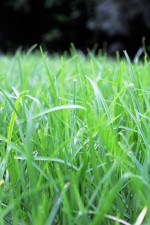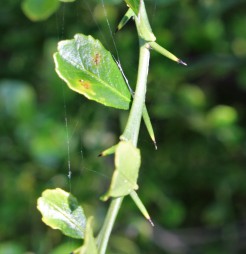
On a damp, March day after a weeks of torrential rain I ventured into the wilds (of my backyard) to seek the fruits of the exotic finger lime. I waded through long grass in mortal fear of stepping on an undiscovered dog poo.
I manoeuvred carefully between the webs of the St Andrew’s Cross spider and the leaf-curling spider – steadfast guardians of the prized fruit.
Ouch ! those spines are painful.

Back through the long grass to get my gloves.
Finally with webs in my hair and puncture wounds in my hands. I plucked the long glossy fruits and took my spoils to the kitchen.
~~~~
Finger limes (Microcitrus australasica) are native fruits of south-eastern Queensland and northern NSW but ours grows well in a sheltered spot in our Illawarra (southern coastal NSW) backyard.
The best way to extract the flesh from the finger lime is to cut off one of the ends and just squeeze with your fingers. It is amazing how much comes out of such a skinny fruit. Using this method you avoid scrapping any of the bitter pith.

The little balls of citrus ‘caviar’ make a pleasant sour explosion in your mouth. This year the taste was really good – light and clean – probably due to the high rainfall. I’m not certain of the variety of my tree, but from googling it looks like a, Jali Red.
I use the finger limes to add zing to water and drinks for the table but have also used them on fish (often mixed with soy sauce). There are more suggestions here if you are interested : http://boutiquecitrus.com.au/finger-lime-recipes-and-ideas/
Our finger lime is a ‘rescue tree’ (alright, alright I’m compensating for not getting a rescue dog). It was given to me as a sapling, by a friend who said her husband refused to have ‘that bloody spiky thing’ in their garden. Overall it gets very little love or light as it is overshadowed by a grevillea and lemonade tree in a south-east corner of the garden.

As long as you don’t put it in a thoroughfare (ouch) and water regularly (it is a rainforest plant) the finger lime tree is low maintenance and an interesting plant to cultivate. I found the fruiting season runs from late December to March in the Illawarra. The fruits don’t hold on very tightly and generally fall off in your hand when they’re ready to pick. This can be a disadvantage – make sure you pick them regularly before they drop to the ground and rot.
Footnote: When I began to write this blog post I fell into writing it like the well-known picture book ‘We’re Going on a Bear Hunt’ ie
We’re going on a lime hunt.
We’re going to pick a big one. etc etc
Back through the spider webs Sticky icky..
Back through the long grass swishy swooshy
It was then I realised 12 X 12 – a year-long picture book challenge was getting to me (more about that later) I also realised that the average age of my reader is probably not 4. So, I hope you like my grown-up version better.





Yum! Finger limes are nice in gin&tonic too! You’ve got a decent crop there. My regular lime tree often flowers but never fruits. But our lemons are compensating by staying green on the outside – masquerading as limes!
LikeLike
Yes I can imagine the G & T or even Corona. Yes our lemonades are doing the same – staying green. But on the plus side our passionfruits are booming.
LikeLike